HECK'S
| Heck's
Department Store, a chain of West Virginia based discount department
stores, was founded by Boone County natives and businessmen Fred
Haddad, Tom Ellis, and Lester Ellis and wholesale distributor Douglas
Cook. The Heck's name was a combination of the names Haddad, Ellis and
Cook. Haddad served as President, Lester Ellis was Vice-President, and
Tom Ellis was Secretary-Treasurer. The first store at 1114 Wash.St. E. opened in 1959 |
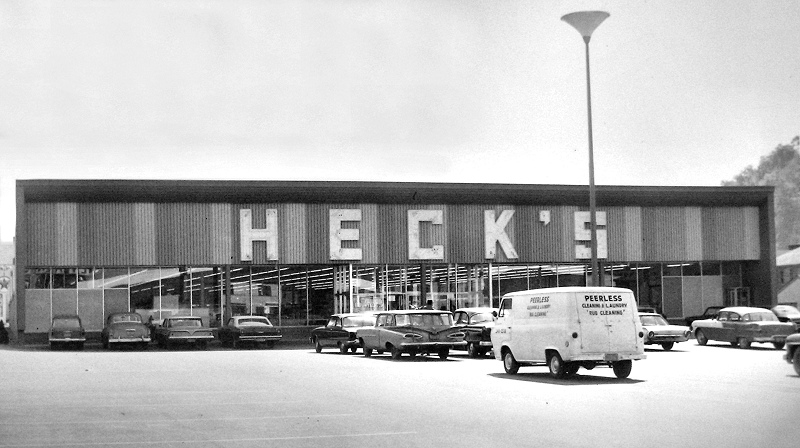
Kanawha City HECK'S
Heck's
stores were discount, stand alone department stores found in small
cities throughout West Virginia, western Maryland, the Ohio Valley, and
parts of Indiana & Kentucky. Its structure and product lines were
similar to its competitors, Fisher's Big Wheel, Hills Department
Stores, G.C. Murphy's Mart and Walmart.
|
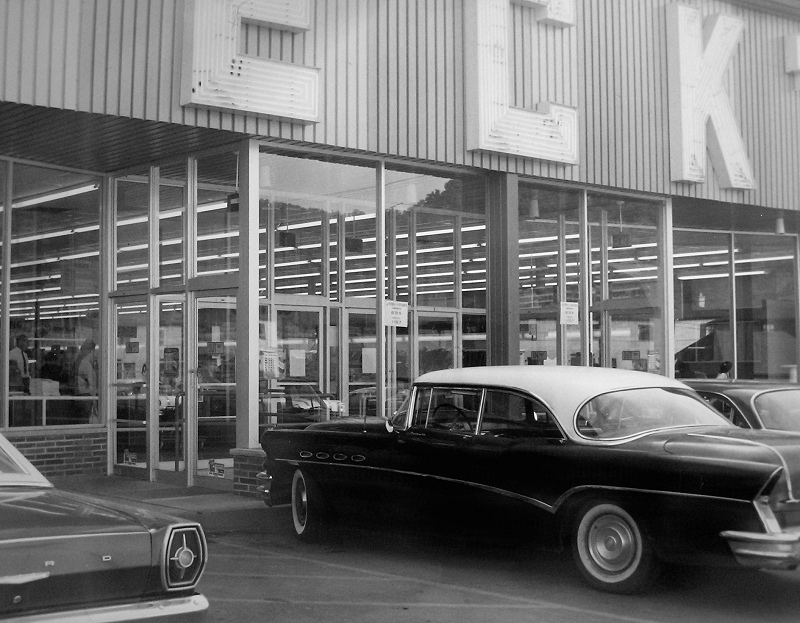
At
its peak in the 1980s, Heck's operated 170 stores throughout West
Virginia, Ohio, Kentucky, Pennsylvania, Indiana, Maryland and Virginia.
Forbes Magazine ranked Heck’s third nationally in profitability and
growth in 1980, beating out Kmart.
In 1983, Haddad retired as
Heck's president and sold his stock in the company. The Ellis brothers
had previously sold out in the 1970's.
Sales fell the following year, and the company saw its first losses in 1984. In 1985, layoffs began, as losses continued.
A
number of factors contributed to Heck’s decline. The U.S. economic
downturn of the early 1980s hit W.Va. particularly hard, and the store
faced increased competition from other chains as well.
|
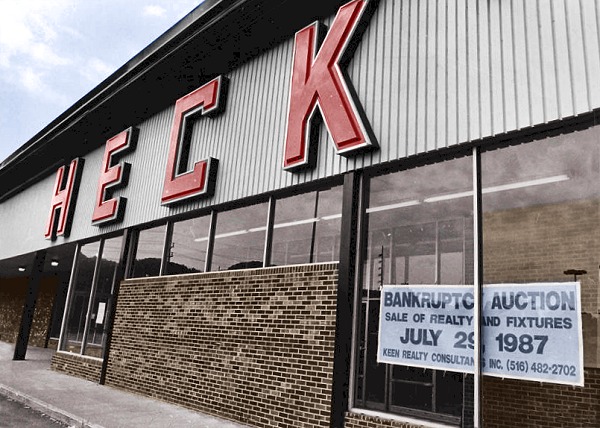
In
1989 the company emerged from Chapter 11 with 55 stores and under a new
name, as Take 10 Discount Club; a membership club costing $10 to join.
In
September 1990 all of the assets of the Retail Division were sold to
Retail Acquisition Corporation, Inc., and became L.A. Joe Department
Stores. Two locations were sold to, and became, Fisher's Big Wheel. One
Location was sold to Gabriel Brothers
A 1991 Philadelphia
Inquirer article lists several factors for the collapse of Heck’s under
the new management, putting the blame on sweeping changes to the stores.
Specifically,
the Inquirer cited customer frustration with constant store redesigns
and products being dropped from inventory. The store also faced major
troubles from costly data errors caused by its new computer accounting
system.
|
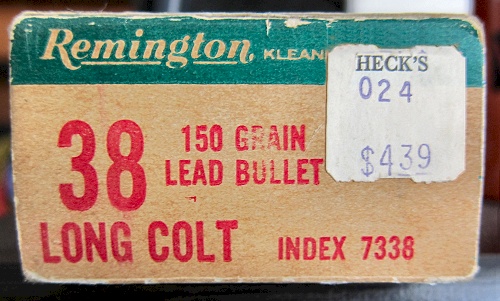 If you're over 50, there's a good chance that you still have something in your house from HECK'S.
|
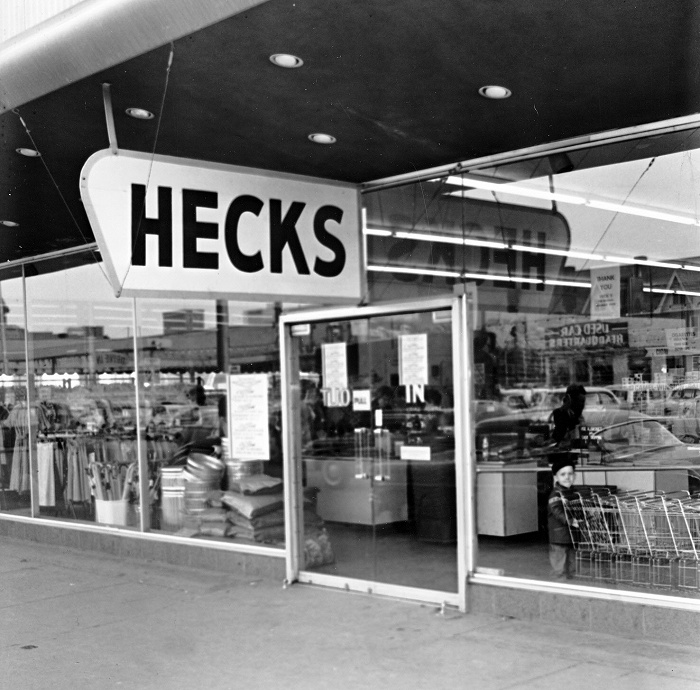
Washington Street East store that would later burn to the ground as a Goodwill store. 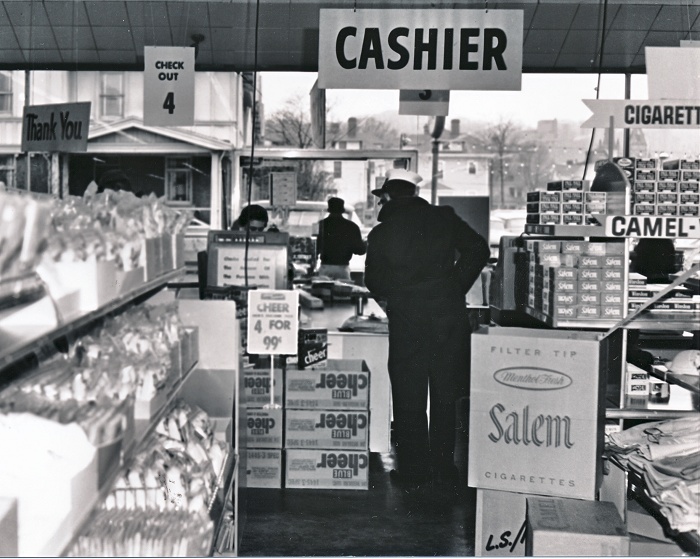
Typical interior of an early Hecks store. 
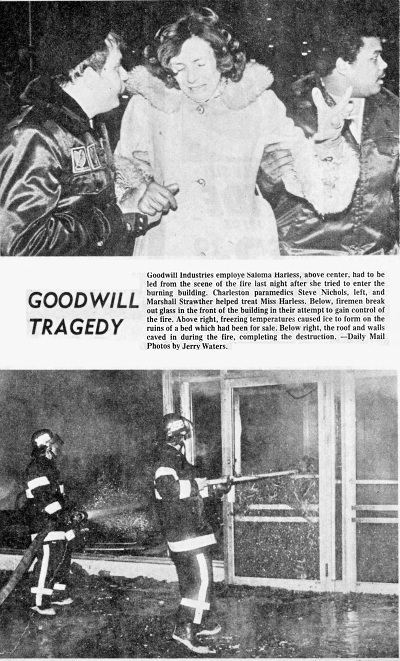
In
1977, the Washington Street East Heck's was a Goodwill store.
On Jan 18, in sub zero temperatures, Charleston fighters had a
real situation on their hands. I was off duty and took these
photos.
|
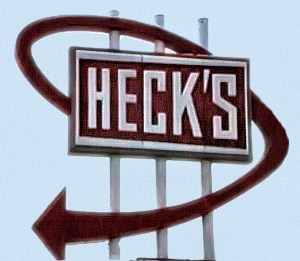
SIDE NOTE:
Ran across this article from 1975 concerning the condition of Capitol Street as a viable business location.
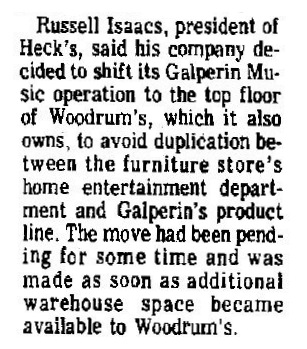
|
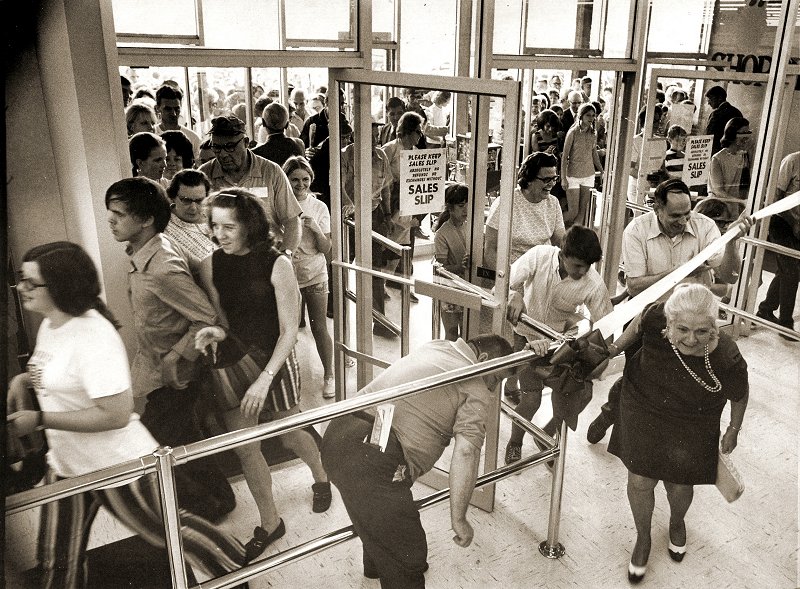 On
Aug. 9, 1971, hundreds of shoppers stood in line at Plaza East
(across the street from the current ballpark) , waiting for the 10 a.m.
opening of the new Heck’s store. Owner Fred Haddad said at that time
that it was the biggest opening day in the history of Heck’s. By
closing time, more than 26,000 shoppers had visited the store. The
store replaced an earlier store on Washington Street that years later
burned down. Heck’s was the largest retailing and wholesaling operation
in West Virginia under in-state ownership. Heck’s officials boasted
$500 million in annual sales, $300 million in assets and 8,000
employees. However, by 1987, Heck’s was in bankruptcy. It was purchased
by Jordache, the designer jeans maker, in 1990, which converted the
remaining locations to LA Joe department stores.
|
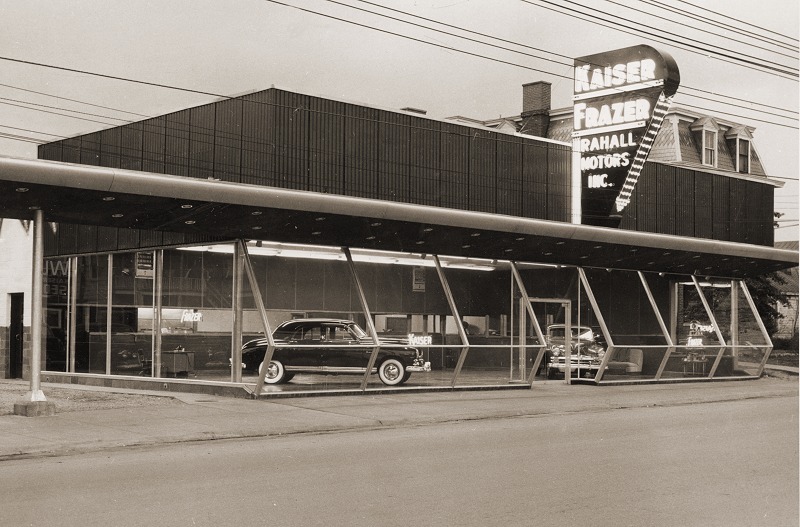
This
is one of the rarest photos that you will ever see. It's Rayhall
Motors, the Kaiser Fraizer Dealership that opened in 1950. Only
open for three years because Kaiser Fraizer went out of business in
1953. This attractive and unusual building would become the first
HECK'S in 1959. The building to the right behind the dealership is the old Davis Child Shelter.
|
©
COPYRIGHT
All
content including articles and photos on this website Copyright 2013 by
J. Waters. All images on this website are used with
permission or
outright ownership of J. Waters.
All newspaper articles
are courtesy of the Charleston Gazette or Daily Mail for the express
use of the author. You do NOT have permission to use any image, article
or material without permission from the author. You do NOT have permission to pull
photos from this website and post them to Facebook or any other
website. Any
material used without permission will be subject to creative copyright
laws.
|
Epilogue
How death came to a once-prosperous discount-store chain
October 25, 1991
by Donald L. Barlett & James B. Steele, PHILADELPHIA INQUIRER STAFF WRITERS
In
March 1987, Russell L. Isaacs, the chief executive officer of Heck's
Inc., received a singular honor. He was selected by the Horatio Alger
Association as one of 10 people from across the country to receive its
annual Distinguished American Award.
The 54-year-old Isaacs that
month joined a prestigious roster of previous award-winners who ranged
from Bernard M. Baruch, adviser to seven presidents, to Raymond A.
Kroc, the founder of McDonald's Corp.
Intended to recognize
rags-to-riches success stories, the awards are given, in the
association's words, to show young people that "opportunity still
knocks in America for anyone willing to work. "
The association
and its awards are named for the author of the popular 19th-century
novels - Ragged Dick and Luck and Pluck, among others - that recounted
the tales of young boys who achieved success, fame and wealth through
hard work, perseverance, honesty and luck.
The association
described the 1987 winners in general as "role models who give others a
different kind of inspiration to succeed. "
In Isaacs' case, the
association related his rise from an impoverished West Virginia family
- his father was a coal miner and his mother "suffered an apparent
stroke" during the birth of her seventh child - to become chairman and
chief executive officer of Heck's, a discount department-store chain
based in Nitro, W. Va., near Charleston.
The association said it
was most fortuitous that Heck's directors had selected Isaacs, who once
had been the company's chief financial officer, to run the entire
operation: "Giving Isaacs free rein has proven to be a wise decision. .
. . His previous knowledge of the company gave him an advantage in
implementing changes he thought most beneficial to the company. "
Well, not exactly.
Actually, Russell Isaacs had just overseen three consecutive years of losses adding up to $31 million.
He had directed the closing of three dozen stores scattered across several states.
He
had fired hundreds of employees, including Bobby Jean McLaughlin and
many others who had worked at Heck's for 10 or 15 years or more.
And
he had presided over the company's relentless downhill decline - a
decline that in time would lead to the elimination of thousands of jobs.
In
fact, on March 5, 1987 - the week before Isaacs was inducted into the
Horatio Alger Association at a dinner in Washington - Heck's Inc. filed
for bankruptcy protection.
The irony is not an isolated one.
For
Russell Isaacs, the $300,000-a-year chief executive, is little
different than thousands of other executives and investors who have
assumed control of American corporations - from retailing businesses to
manufacturing plants.
He is a financial officer by training. And
by all accounts a good one. But aside from a grasp of the numbers, his
critics say, he had little understanding of the business he was
running, or what made it work.
Listen to Douglas R. Cook, one of
the founders of Heck's who left when Isaacs took over: "Russell is a
certified public accountant and a good financial man. Unfortunately . .
. there's a difference between a financial man and a hands-on manager. "
Cook,
who with three other men built Heck's from a single department store in
Charleston to a chain of more than 120 stores across the
middle-Atlantic states, added:
"I always tell people, if you
started out to destroy a company, you couldn't have done as good a job
as Russell Isaacs did. . . . He . . . tried to make a lot of changes,
tried to fix a lot of things that weren't broken. "
Isaacs has a different explanation.
When
Kmart and Hills built stores "two or three times the size of ours, you
know it doesn't take a rocket scientist to figure out you can't compete
with that size store," he said. "Just picture a 40,000-square-foot
store beside a 120,000-square-foot store. Where's the customer going to
go? He's going to go where the selection is the greatest and prices are
the best. "
While Heck's no longer exists and thousands of employees lost their jobs, there were a few notable financial success stories.
One
was Russell Isaacs'. As was the case with many corporate executives and
investors, Isaacs, his managers and those who followed him received
millions of dollars, collectively, in generous compensation packages,
pensions and severance contracts.
By contrast, Patsy J. Perry of
Teas Valley, W. Va., one of the many longtime Heck's workers dismissed
by Isaacs and his successors during a string of failed reorganization
efforts, received little more than $1,000.
The money represented
her pension for 12 years' work. There was no severance pay for Perry,
56, who lives alone and supports herself. There was no interim
allowance to tide her over until she found another job.
More important for Perry, a diabetic who takes insulin daily, the medical insurance that Heck's provided was terminated.
For two years, Perry said, she could not afford regular medical checkups. Her vision deteriorated because of the diabetes.
Still,
she recalled fondly the early years at Heck's. "We were just like one
big family," she said. "In fact, that's what they called it - Heck's
family. "
To understand how that family was born and prospered,
and then withered and died, it is necessary to turn back the clock to
1959. The place is downtown Charleston, in an empty building that had
housed a Kaiser-Fraser auto dealership.
It was there that Fred
Haddad; brothers Tom and Lester Ellis, and Douglas Cook opened their
first discount department store. Haddad and the Ellises had operated
competing stores in nearby Madison, W. Va. Cook was working for a
wholesale distributor.
The new store - called Heck's after the
letters in the names of the founders and two friends - proved an
instant success. A second was opened in 1960 in St. Albans, W. Va.,
Cook recalled, "and about a week or two later we opened our third store
in Huntington. "
Fred Haddad was Heck's chairman of the board
and president, a hands-on executive who wandered through the stores and
knew his employees by name. Cook was in charge of merchandising and
advertising.
By 1963, they had expanded beyond West Virginia, opening stores in Kentucky, Maryland and Virginia.
From
the very beginning, according to Cook, the company was profitable: ''We
showed a good profit. And it was profitable every year up until, say,
1984. "
By 1983, when Haddad retired and sold his Heck's stock, the company had grown to 122 stores with annual sales of $435 million.
Although
net income trailed off in 1983 to $10 million from a peak of $15
million in 1980, Heck's still had posted 24 consecutive years of
profits.
Then it all unraveled.
Haddad was replaced by
Russell Isaacs, who had worked for Heck's in the 1960s and '70s before
becoming executive vice president of Wheat First Securities Inc., a
Richmond, Va., brokerage firm.
Isaacs recruited new managers, introduced new marketing concepts, redesigned store layouts, and added a new computer system.
As
part of the sweeping overhaul, Isaacs said in a report to shareholders,
''each store was planogrammed, a photo-optical process that allocates
product space uniformly . . . according to a master plan based upon
sales. "
"Hence, fast-moving products were given greater shelf
space and a better position than slower-moving items. In addition,
low-profit and marginal products were dropped from Heck's product mix,
an important step in improving store productivity . . . "
The
rearranged layouts, Isaacs said, included "one or more racetrack aisles
leading shoppers to prominent departments through the store. The
racetracks were dotted with speed tables featuring fast-moving and
desirable merchandise to attract shoppers. "
Isaacs concluded
that "though the overall effort was massive and frequently caused
dislocation to shoppers, the initial results indicate a positive
response. "
Well, not too positive.
Despite - or perhaps
because of - the racetrack aisles, photo-optical process and upscale
merchandise, Heck's celebrated its silver anniversary in 1984 by
recording its first loss ever: $8 million.
Along the way,
veteran Heck's employees heard a mounting chorus of complaints from
customers who were irked when they were unable to buy products the
chain had stocked for years but no longer carried.
Like Lucite
paint. Perry said it was one of the biggest sellers in the store where
she worked, but the new management "did away with it and went to
another brand. . . . I know the other paint didn't sell. "
Douglas
Cook agreed. "We had a big following in that," he said. "We had regular
customers. . . . We did a terrific amount of Lucite business. . . . The
first thing that Russell Isaacs' new management team does is throw out
Lucite paint. . . . That's a good example of (why) . . . the customers
get upset. "
The ever-changing store layouts also caused
confusion. "Every time you turned around," Perry said, "they were
changing something. All the customers complained because they never
could find anything . . . "
In any event, Russell Isaacs, fresh
from the experiences of his own investment firm and a satellite Wall
Street investment house, plunged ahead - with more changes.
He
next did what so many other executives were - and still are - doing
when confronted with an ailing business: He sought to acquire other
businesses.
In 1985, he bought another retailer, Maloney
Enterprises Inc., which operated 34 discount department stores in
Heck's marketing area. The selling price was right.
That's
because Maloney's had filed for reorganization under the U. S.
Bankruptcy Code in 1982 and was just emerging from court protection.
The acquisition, completed in August 1985, brought the number of Heck's stores to 166.
That
same month, Heck's picked up a quick $9 million from the IRS by
applying its 1984 net operating loss against taxes paid in earlier
years when the company was profitable.
Even so, Heck's was sinking fast.
On
Sept. 4, 1985, the company borrowed $4 million from Algemene Bank
Nederland NV, a Netherlands bank. Two weeks later, it borrowed an
additional $1 million.
Next, it began firing dozens of workers.
On
Friday, Oct. 11, 1985, Heck's management sat down to decide who would
go. It later seemed to some that many employees selected for
termination were those with the most experience - and the most pay and
benefits.
There was Bobby Jean McLaughlin, now 57, who was
earning $6.20 an hour as a department manager after 18 years with
Heck's. That gave her a base salary of less than $13,000 a year.
And
there was Patsy Perry, who was earning $5.60 an hour as a supervisor
after 12 years with Heck's. That gave her a base salary of less than
$12,000 a year.
During an interview, Perry recounted her
dismissal: "They just came in one morning, the store manager and the
supervisor, and called me and another lady and told us as of today we
were being laid off.
"I was so upset. I asked them if we could
work in a different part of the store if they were doing away with our
jobs. And they said no, they weren't doing it that way. . . . They were
just letting us go. . . .
"They had us to go home as soon as they told us. They thought it would be better if we leave the store immediately, they said. "
Employees were stunned.
"It
was a shock," Perry said. "My mother was here visiting. . . . When I
came home, I cried and cried. She nearly thought I was going to have a
stroke. That night, the girls (from the store) kept coming over to the
house. It was like a funeral. "
The timing of her firing had a
bitter twist for Perry, who had lived for years in her own home in St.
Albans, W. Va., about 15 miles from the store.
"I sold it in
September," she said, "and bought me a little trailer and a lot . . .
so I'd be close to work and I could be here till I retired . . . about
five minutes away. And then I got laid off the next month. "
Other
former Heck's employees, particularly those over 40, found themselves
unable to obtain a job that paid comparable wages or benefits.
Betty
Jean Thompson, a widow, was terminated as a $6.09-an-hour department
manager after 11 years. Thompson, now 60, eventually was hired by
another retailer - but for only 20 hours' work a week. Her new salary:
$3.50 an hour. That represented a 43 percent pay cut. There was no
health insurance. No life insurance. No pension.
For a brief
time, the firings of people such as Betty Jean Thompson and Bobby Jean
McLaughlin and Patsy Perry appeared to stem the tide of red ink at
Heck's.
Indeed, company executives forecast a return to profitability by year's end.
The
optimism was unfounded. As it turned out, Heck's new management team
had failed to detect data errors in yet another of its fresh
merchandising and cost-control innovations - a new computerized
accounting system. The computer, it seemed, abetted by human error, ran
amok.
Price markdowns on merchandise went unrecorded, thereby
creating fictitious profits. Invoices were incorrectly marked, which
led to the reordering of unneeded goods.
A company spokesman was quoted as saying: "When you have computers and people messing up, you have a big problem. "
By the time all the bookkeeping errors had been corrected, Heck's had posted a $5 million loss for 1985.
The
longtime employees had seen it coming. Recalled Bobby Jean McLaughlin:
''I would order six eyebrow pencils. Two or three dozen would come in.
. . . They had people who didn't know what they were doing. "
That
was none too surprising, given the stream of new management recruits.
''That's all you saw," she said, "were people from different places.
They brought people in to show us how to set the shelves and all that
stuff, like we weren't smart enough. They brought all those big shots
in. "
Isaacs labeled the accounting breakdown nothing more than
"a temporary setback in our efforts to return the company to a strong,
profitable operation. "
Nevertheless, to shore up Heck's shaky finances, the board of directors in April 1986 embarked on another money-raising course:
It voted to raid the company's pension fund.
On
Oct. 30, 1986, Heck's informed the Pension Benefit Guaranty Corp. that
it intended to withdraw $4.6 million of the $7.4 million in the
retirement fund.
Heck's management was going to take 62 percent
of the fund's assets and use them to help bail out the business. That
would leave 38 percent of the assets, or $2.8 million, to be
distributed among 3,251 employees with vested pensions.
That worked out to an average of $861 for each employee.
Isaacs
and Ray O. Darnall, who had served as president and later vice chairman
of the Heck's board, did a little better. According to records filed
with the U. S. Securities and Exchange Commission, Isaacs collected
$134,494 from the terminated pension plan, and Darnall picked up
$397,851.
The pension fund raid failed to shore up the company's shaky finances. Heck's ended 1986 with a loss of $18 million.
On
March 5, 1987, five months after Heck's submitted the pension plan
termination to the PBGC, the company filed for protection in U.S.
Bankruptcy Court.
As the year wore on, however, Isaacs expressed continued confidence in the plan to restore Heck's to profitability.
To
that end, in August 1987 he announced the appointment of a new
president with a similar-sounding name. He was John R. Isaac Jr., who
had worked for several retailers, including Service Merchandise Co. and
a subsidiary of Federated Department Stores.
Russell Isaacs was
enthusiastic about the new president: "We believe his extensive
retailing background will be instrumental in helping Heck's effect the
recovery it has been working so diligently to achieve. I'm just tickled
to death with him. "
John Isaac most recently had been president
of Tradevest Inc., a Florida mail-order company that attorneys general
in several states had labeled a pyramid scheme.
Tradevest
peddled $789 subscriptions to a mail-order purchase club. Once people
joined the club, they could sell subscriptions to others and collect a
commission.
In return for their fee, members were assured they
could earn a rebate of 90 percent of what they spent buying products.
The rebate would come as an annuity - to be paid 20 years after the
purchase.
Soon after John Isaac left the mail-order business to
take over day-to-day operations at Heck's, Tradevest filed for
protection under the U. S. Bankruptcy Code.
But John Isaac was
confident about Heck's. A discount-store trade publication quoted him
at the time as saying that "the company has been making good progress
in redefining its basic core group of stores and in re- evaluating its
future direction. I'm very optimistic . . . "
Once more, the
optimism proved unfounded. Heck's ended 1987 with another loss. In
fact, the loss of $61 million was almost double the cumulative losses
of the preceding three years.
John Isaac, who recruited new
management, including former employees at Tradevest, ended the year by
closing eight more stores and dismissing scores of employees.
By
June 1988, John Isaac had a new plan: He would sell off or close an
additional 40 stores, fire hundreds more employees. A company news
release used all the catch phrases that have become so much a part of
corporate jargon to justify eliminating businesses.
John Isaac
said "the restructuring would enable the company to dispose of assets
which have not provided an adequate return on investment . . . and
which the company believes provide only limited growth potential for
the future. "
It was to no avail. The losses continued to pile up. Heck's stores continued to disappear.
From a high of 166 stores, the retailer shrank to 55 stores. Employment plummeted from more than 7,000 workers to 1,700.
By
January 1990, the name Heck's had vanished; the remaining stores were
renamed the Take 10 Discount Club - as in pay $5 to become a member and
take 10 percent off everything.
Total Heck's losses for 1988 and 1989: $85.5 million.
In
February 1990, the management of Take 10 Discount Club sold the
business to a subsidiary of Jordache Enterprises Inc. The sale price:
$1 and the assumption of $22 million in debt. The remaining stores
scattered across the hills of Appalachia were relabeled L.A. Joe
Department Stores. One year later, L.A. Joe was in Bankruptcy Court.
The stores have since been closed.
One statistical footnote to the collapse of a once-successful regional retailer:
John
Isaac, who earned $360,000 a year in the top job at Heck's, and four
associates who managed the final dismantling of the company, collected
more than $1.5 million in severance pay.
Patsy Perry did not fare so well.
Although
she subsequently found work in a convenience store, Perry said that she
did not make as much as she did at Heck's. What's more, two years went
by before she qualified for medical insurance. During that time, her
eyesight deteriorated and she had laser surgery on both eyes. She also
underwent a hysterectomy.
As for the medical bills run up during the time she had no health insurance, Perry said:
"I still owe almost $4,000 to them people which I can't begin to pay. So I don't know what's going to happen. "
When
she was off work for an extended period, she lost her job at the
convenience store. She since has found another job working about 30
hours a week for minimum wage, and she has some insurance.
The job is at a Value City discount store housed in an old Heck's building.
|

Back to Index
|





